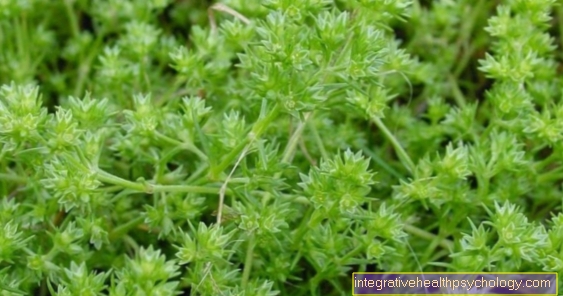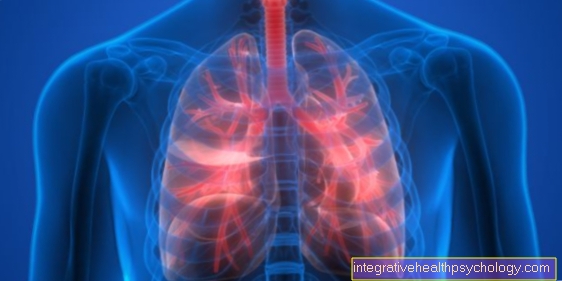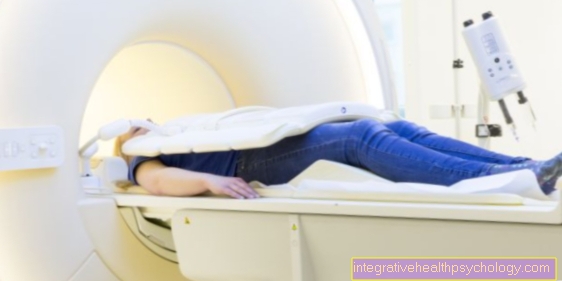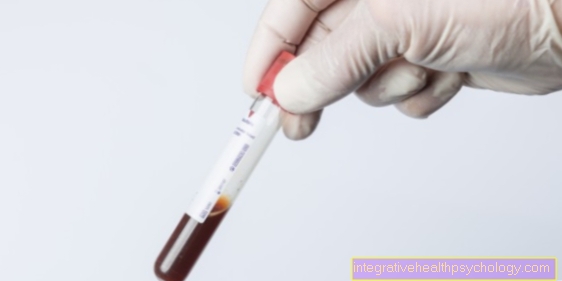Diet for fatty liver
definition
From one Fatty liver (Stetatosis hepatis) is usually spoken when there is a potentially reversible fat storage in the liver cells (hepatocytes). This obesity can still be reversed.
Fatty liver can have various causes, such as chronic alcohol consumption or non-alcoholic reasons (non-alcoholic-fat-liver disease) Lipid metabolism disorders, Overeating, obesity and type 2 diabetes mellitus.

This must be differentiated from steatohepatitis, in which there are also signs of inflammation.
Another term to be distinguished from this is alcoholic fatty liver disease. This term is often incorrectly used synonymously for fatty liver, but does not describe a single clinical picture, but encompasses a group of diseases.
This includes the simple fatty liver, but also fatty liver hepatitis (steatohepatitis), which Cirrhosis of the liver as well as that hepatocellular carcinoma.
The following article is about fatty liver disease and the specific dietary aspects that should be considered in the case of fatty liver disease.
What should you watch out for?
The presence of fatty liver represents one serious condition the liver, which can be caused by various factors. A fatty liver can, for example, as a result of a excessive alcohol consumption, as part of a metabolic syndrome, from overeating and Obesity, or with other pre-existing conditions.
Generally the mortality in patients with fatty liver hepatitis, which can arise from fatty liver, and the resulting complications increased compared to the normal healthy population.
Such secondary diseases can affect the heart and the vascular system, for example. The risk of this is very high, especially in patients with alcohol abuse, a metabolic syndrome and associated obesity.
Further complications such as a Cirrhosis of the liver or one Tumor disease of the liver (hepatocellular carcinoma) can also develop from fatty liver. It is therefore advisable to clarify the cause of the fatty liver and to minimize risk factors as much as possible.
Patients whose fatty liver can originally be traced back to their diet, or at least in part to their diet, should pay particular attention to them.
nutrition
Recommended foods
The dietary recommendations for fatty liver or fatty liver hepatitis are aimed at different things. Many patients with fatty liver disease have overeating or metabolic syndrome.
A central risk factor for the development of such a fatty liver are all the conditions that one Insulin resistance bring with it such. E.g. a Type 2 diabetes mellitus or one Lipid metabolism disorder. In general, therefore, is a moderate weight loss and Diet change recommended.
Several studies have shown that high-calorie snacks and snacks, as well as sweetened drinks and sugary juices, have a negative effect on the development of fatty liver.
Protective, however, should Mediterranean food be. It is recommended with cold-pressed olive oil to cook. This also seems to have positive effects on the cardiovascular (cardiovascular) risk of those affected. In addition to olive oil, other oils such as rapeseed oil, walnut oil, and wheat germ oil are also good alternatives. In studies, however, olive oil was clearly superior in terms of reducing cardiovascular risk.
Meals are still recommended lots of vegetables, Dairy products with a low percentage of fat, fruit and its low-salt diet. Basically, all vegetables are recommended, only corn should be avoided. Look out for one low fat content of dairy products and prefer lean cheeses, such as cottage cheese or cream cheese. Also Eggs are desirable for a balanced diet.
When consuming fruit, one should pay attention to Fruits with as little fructose as possible to prefer. These include, for example, the avocado, papaya, honeydew melon and apricot. Peaches, mandarins, nectarines, blackberries, raspberries, strawberries, grapefruit and pineapples also contain comparatively little fructose.
Instead of white bread you should whole grain products be consumed because they keep blood sugar stable for longer and ensure a longer-lasting feeling of satiety. These include, for example, whole-grain bread, whole-grain pasta and whole-grain rice. Unsweetened muesli and oatmeal are also recommended.
However, the following rule applies to all these cereal products: Everything in moderation! Because excessive consumption of "good" carbohydrates can also promote obesity.
fish is very healthy due to its high quality unsaturated fatty acids and should not be missing in the diet. Basically every fish is recommended, but you should avoid fatty breadings and sauces.
According to the recommendation of the German Nutrition Society, meat consumption should generally not be more than 300 to 600 grams per week. Lean meat is clearly preferable to very fatty pieces. Fillet pieces of beef and pork, as well as turkey and chicken breasts are recommended.
Also, look out for one adequate hydration (2-3 liters daily) in the form of water and unsweetened tea. You don't have to go without coffee either.
Foods to Avoid
There are a number of foods to avoid when you have fatty liver.
In particular fatty and sugary snacks should be avoided. You should also absolutely avoid sweetened drinks, fruit juices, soft drinks and alcohol. They drive up blood sugar, lead to food cravings and promote the development of fatty liver.
In general, high calorie snacks should be avoided. Studies have shown that these snacks in particular have negative effects. Sweets as well as salty ones crisps and sugary snacks should also be avoided.
Also refrain from White bread, toast and durum wheat noodles. Also husked rice, French fries, Pancakes and potato pancakes shouldn't be on the nutrition plan.
Furthermore is Fruit with a high percentage of fructose not recommended. These include grapes, pears, apples, mango and cherries. Preserved fruit and candied fruit should also be avoided.
Refrain from cooking animal fat like lard or goose lard. Sunflower oil, safflower oil, palm fat and clarified butter should also be avoided.
The basic rule for dairy products is that all products with a low fat content should be preferred to products with a high fat content. Hence, they should mostly be on fatty cheese, Fruit yoghurts, cream, puddings, buttermilk and mayonnaise.
Also fatty meat such as meat loaf, breaded meat, mortadella, meat sausage, salami, pork belly and neck meat or fatty breaded fish should be avoided.
Nutritional example
The following section aims to exemplary a nutrition plan for one day. This nutrition plan is not intended as a recommendation, but is only intended to be an example of a possible combination of foods that are recommended for fatty liver disease.
- 1. Breakfast: Porridge with fruit:
Porridge is a particularly popular, filling and healthy breakfast. For two servings you need about 350 ml low-fat milk, 6 tablespoons of oatmeal and a pinch of salt.
In a saucepan, bring the ingredients to a boil while stirring. Then let the porridge cool down.
Cut fruit into the cooled porridge as desired. If you want to sweeten the breakfast, you can add a teaspoon of honey or agave syrup.
- 2nd lunch: couscous with chicken:
Heat two tablespoons of olive oil in a large saucepan. Put diced chicken, 125 grams per person, in the hot oil and fry it all over.
Now you can dice vegetables as you like and sauté them in the oil. For example, add carrots, celery, onions and peppers. Now extinguish the whole thing with 2 glasses of water or broth.
Add 100 grams of couscous and let everything simmer together for about 10 minutes. Then take the couscous off the stove and add salt, pepper and herbs as desired.
- 3rd in between meal: yoghurt dip:
As a snack between meals, we recommend lean yoghurt with fruit or sliced vegetables with a homemade yoghurt dip.
To do this, take low-fat yogurt or cottage cheese. Add a pinch of salt and pepper, as well as mint and a teaspoon of honey.
- 4th dinner: avocado with tomato filling:
Cut an avocado in half and loosen the stone. Sprinkle some salt and pepper on the avocado halves. Cut two tomatoes into small cubes.
Cut the green portion of the fresh spring onions into the tomato cubes. Add a teaspoon of olive oil, a pinch of salt and pepper and a dash of balsamic vinegar to the diced tomatoes. Now pour the mixture into the hollows of the avocado.
Summarizing general tips
In general, it is advisable to pay attention to the following things with fatty liver:
- 1. Existing Obesity should be reduced.
- 2. Diet change: The daily calorie intake should be adjusted as needed. Do they prefer whole grains and lean meat and dairy products. Avoid sweetened drinks and sugary snacks. A low-salt diet is recommended. Instead of using animal fats, it is best to give preference to polyunsaturated fats like olive oil. Vegetables and fruits should also be on your menu.
- 3. No alcohol! Alcohol is damaging to the liver anyway and should therefore not be consumed if you have fatty liver.
- 4. Regular exercise and sport: Regular exercise and sport also have positive effects and should be integrated into the daily schedule.
Further therapeutic measures for fatty liver
There are currently no drugs approved for the treatment of fatty liver.
Besides the Lifestyle changesthat include, for example, a healthy diet and regular exercise, are aimed at medicinal measures in particular Comorbidities which often occur in connection with fatty liver and the associated obesity. This is, for example, a diabetes mellitus, a high blood pressure or cirrhosis of the liver.
If you are very overweight that cannot be reduced by changing your diet and exercising alone, weight-reducing surgery can be considered.


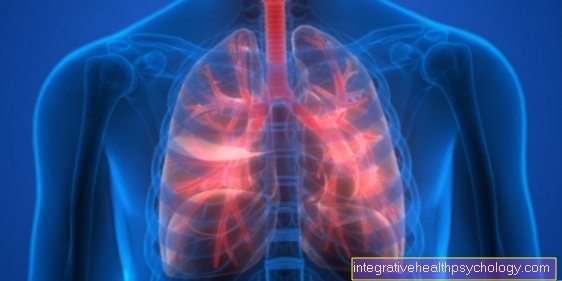


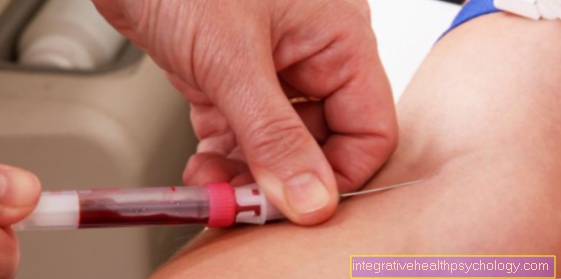




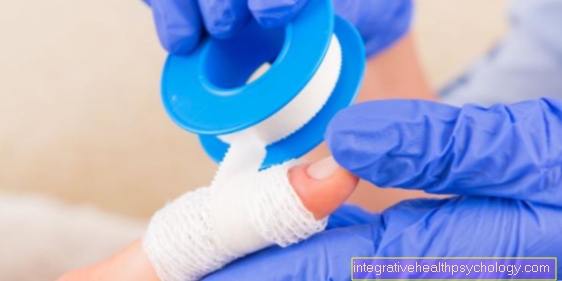





.jpg)



